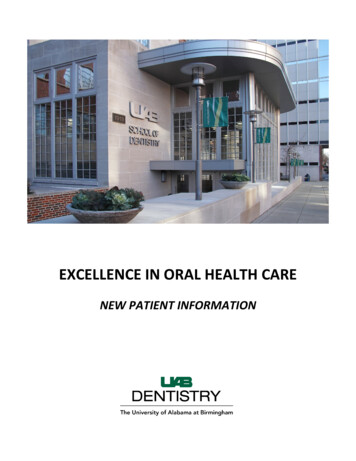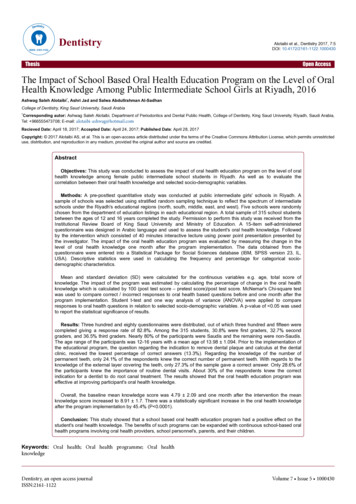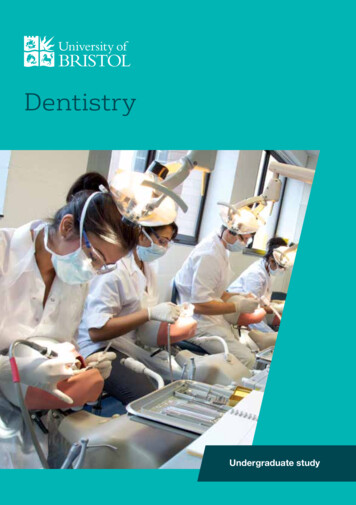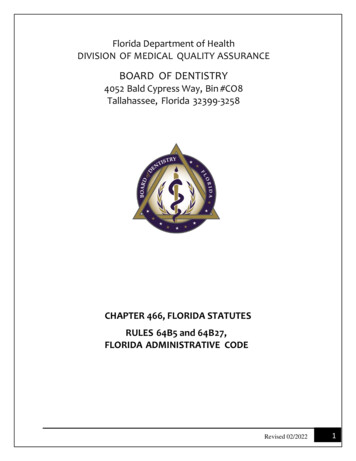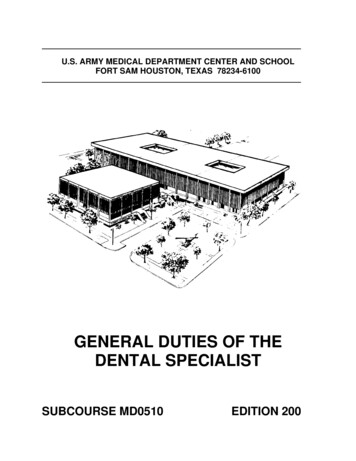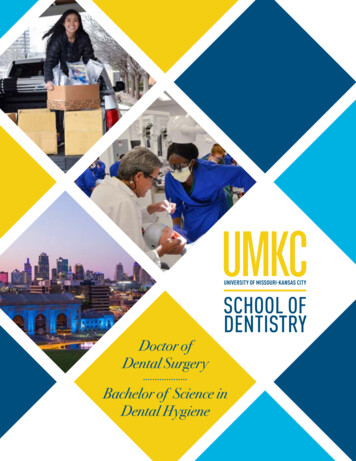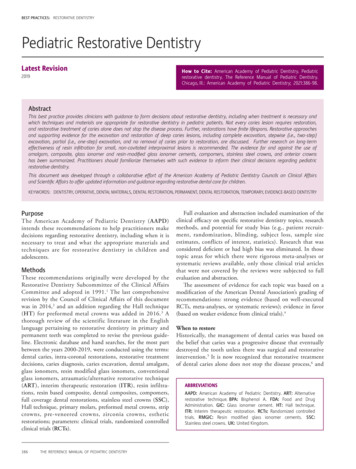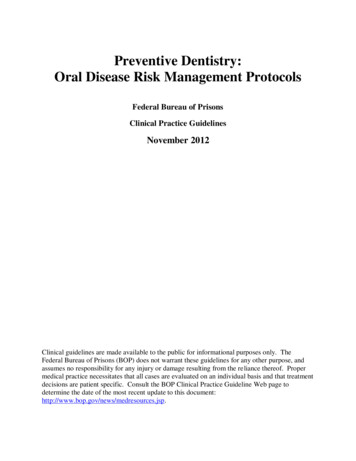
Transcription
Preventive Dentistry:Oral Disease Risk Management ProtocolsFederal Bureau of PrisonsClinical Practice GuidelinesNovember 2012Clinical guidelines are made available to the public for informational purposes only. TheFederal Bureau of Prisons (BOP) does not warrant these guidelines for any other purpose, andassumes no responsibility for any injury or damage resulting from the reliance thereof. Propermedical practice necessitates that all cases are evaluated on an individual basis and that treatmentdecisions are patient specific. Consult the BOP Clinical Practice Guideline Web page todetermine the date of the most recent update to this document:http://www.bop.gov/news/medresources.jsp.
Federal Bureau of PrisonsClinical Practice GuidelinesPreventive DentistryNovember 2012Table of ContentsOverview .1Dental Caries .21. Tooth Decay: A Chronic Disease. 22. Topical Fluoride as Preventative Therapy . 2Research on Fluoride’s Effectiveness .3Types of Fluoride (F) .43. Dental Caries Risk Assessment . 44. Treatment Protocol for Patients at High Risk for Dental Caries . 6Patient Education .6Treatment .7Documentation .7Periodontal Disease .81. Terminology. 82. Periodontal Disease Risk Management Protocol . 93. Treatment Protocols for Various Clinical Diagnoses . 10Chronic Periodontitis (Non-Surgical Treatment) . 10Aggressive Periodontitis (Non-Surgical Treatment). 10Diabetics and Smokers (Non-Surgical Treatment) . 11Dental Implant Maintenance . 12Removing Deposits from Dental Implants . 12Oral Cancer Risk Assessment . 13References. 15Attachments: Inmate Fact Sheets . 17Inmate Factsheet: How to Reduce Your Risk of Tooth Decay. 18Inmate Factsheet: How to Reduce Your Risk of Periodontal (Gum) Diseases . 19Inmate Factsheet: About Your Oral Cancer Screening . 20TablesTable 1.Table 2.Table 3.Table 4.Risk Criteria for Dental Caries. 5BOP Protocol for Dental Caries Risk Management . 6BOP Protocol for Periodontal Diseases Risk Management . 10Medications Available on BOP Formulary for Periodontal DiseasePrevention and Management . 11Table 5. BOP Protocol for Oral Cancer Risk Management . 14i
Federal Bureau of PrisonsClinical Practice GuidelinesPreventive DentistryNovember 2012OverviewScope and Purpose of These GuidelinesThe subject matter in this document applies to all personnel working in the BOP Dental Service.All BOP facilities are encouraged to follow this program in the dental treatment of their inmates.This document establishes guidelines for identifying and managing oral disease risks in theFederal Bureau of Prisons (BOP) Health Care System. The BOP Clinical Practice Guidelinesfor Preventive Dentistry represent a collation of acceptable practices for the dental managementand treatment of oral conditions, including dental caries, periodontal disease, and oral cancer.Early detection of disease and intervention can significantly improve the oral health andwell-being of inmate patients.These guidelines provide a framework for the delivery of quality oral healthcare/preventiveservices, and to sustain continuous improvement of dental practice in the BOP. They are notintended to restrict individual clinical judgment.Focus on PreventionModern methodology for the prevention of progressive oral diseases includes the identificationof patients at high risk of developing diseases. These individuals are distinguished bydemographics, lifestyles, and other risk indicators associated with the diseases.Prevention is the most cost-effective means of controlling oral diseases and improving oralhealth among the BOP inmate population. Standardization of risk management protocols helpsto direct appropriate treatment, based on risk levels.These guidelines are complementary to the American Dental Association (ADA) ClinicalPractice Parameters, applicable sections of the ADA Principles of Ethics and Code ofProfessional Conduct, and other nationally recognized guidelines cited in this document. Themost recent versions of cited professional guidelines take precedence over previously publishededitions. Providers and clinical quality managers should be knowledgeable about these and otherpertinent guidelines, and should use them to develop effective programs to ensure quality careand the safety and health of patients and dental personnel.The treatment protocols, based on the best available evidence, are intended to help guidetreatment decisions regarding diagnosis, management, and treatment of oral diseases, includingdental caries, periodontal disease, and oral cancer. Implementation of these treatment guidelinesis encouraged, based upon availability of resources, patients’ compliance, and providers’professional expertise and clinical judgment.Evidence-Based Dentistry (EBD)Evidenced-Based Dentistry forms the basis of clinical practice in the BOP Dental Service. TheADA (ADA Council on Scientific Affairs, 2006) defines the term “evidence-based dentistry” asfollows: EBD is an approach to oral health care that requires the judicious integration ofsystematic assessments of clinically relevant scientific evidence, relating to the patient’s oral andmedical condition and history, with the dentist’s clinical expertise and the patient’s treatmentneeds and preferences.1
Federal Bureau of PrisonsClinical Practice GuidelinesPreventive DentistryNovember 2012Dental Caries1. Tooth Decay: A Chronic DiseaseTooth decay (dental caries) is one of the most prevalent chronic diseases of people worldwide;individuals are susceptible to this disease throughout their lifetimes. A study published in 2005found that 90% of adults had dental caries in their permanent teeth, and 23% had untreated toothdecay (Beltrán-Aguilar, et al., 2005).Tooth mineral is normally lost and gained in a continuous process of deminerlization andremineralization. Dental caries is a disease of the hard tissues of the tooth, occurring when thedemineralization, caused by cariogenic bacteria, exceeds remineralization. Over time, dentalcaries forms through a complex interaction between acid-producing bacteria and fermentablecarbohydrate, influenced by many host factors including condition of the teeth and saliva flow.The disease affects both the crowns and roots of teeth, and it can arise in early childhood as anaggressive form of tooth decay that affects the primary teeth of children.Initially, caries appears as white spots. Active caries appears as rough, opaque spots, whileinactive caries is hard and appears shiny. Active caries progresses from decalcified spots tocavitation. If left untreated, the disease progresses to pain, infection, and eventual tooth loss.2. Topical Fluoride as Preventative TherapyDentistry has increasingly incorporated the medical mode of treatment, turning topharmacological agents to arrest and reverse the disease process, instead of relying solely onsurgical interventions (as in the past) to repair dentition after the disease has taken its toll.Presently, several methods are employed for the prevention and remineralization of caries,including the application of fluoride, chlorhexidine (CHX), xylitol, and casein phosphopeptideamorphous calcium phosphate (CPP-ACP). The protocols in these guidelines promote the application of topical fluoride therapy sincethere is consistent and strong evidence of its effectiveness, based on a sizable body ofevidence from randomized controlled trials.Fluoride is a mineral that helps prevent tooth decay by enhancing remineralization of affected(demineralized) enamel, converting the tooth’s calcium mineral apatite into fluorapatite, whichmakes tooth enamel more resistant to bacteria-generated acid attacks. Fluoride treatment hasbeen the mainstay of caries prevention therapy since the introduction of water fluoridation oversix decades ago (Grand Rapids, Michigan, was fluoridated in 1945). Fluoride helps to controlthe initiation and progression of caries. The effect of fluoride is largely topical. Different modesof fluoride applications are available, including fluoride dentifrices (toothpastes), gels, mouthrinses, and varnishes.2
Federal Bureau of PrisonsClinical Practice GuidelinesPreventive DentistryNovember 2012Research on Fluoride’s EffectivenessSystematic reviews and meta-analyses of fluoride treatment for caries prevention (predominantlyon children and adolescents) show that: Fluoride toothpaste concentrations of 1000 ppm or above are significantly better thanplacebo. There is some evidence of a dose-dependent effect, i.e., the higher the fluorideconcentration, the greater the effectiveness, but the differences were not always statisticallysignificant. (Walsh, et al., 2010) Fluoride toothpastes appear to be similar to mouth rinses and gels in effectiveness. Thedata comparing varnishes to mouth rinses and gels found that fluoride toothpastes,mouth rinses, and gels reduce tooth decay in children and adolescents to a similar extent.Nevertheless, toothpastes are more likely to be regularly used. (Marinho, et al., 2004b) The benefits of combination regimens are unclear. The meta-analysis of the nine studiesassessing the effect of fluoride mouth rinses, gels, or varnishes used in combination withfluoride toothpaste on the permanent dentition indicates that their combined use is associatedwith a reduction in decayed, missing, and filled tooth surfaces. However, the averagereduction of 10% was not substantial. (Marinho, et al., 2004a) Periodic, professionally applied fluoride is recommended for some patients. Evidencebased clinical recommendations for professionally-applied fluoride in caries prevention,among moderate- and high-risk adults, call for the application of fluoride gel or varnish every3 to 6 months, depending on the caries risk levels. Low-risk adults may not receiveadditional benefit from professional topical fluoride application; fluoridated water andfluoride toothpastes may provide adequate caries prevention in this risk category. (ADACouncil on Scientific Affairs, 2006) Existing strategies for caries prevention are also likely to be effective for arresting andreversing early caries lesions. Strategies for primary prevention and remineralizationinclude topical application of fluorides. The research data on fluorides in water anddentifrices support their efficacy. The data also supports the use of fluoride varnishes. (NIHConsensus Development Panel, 2001) Fluoride reduces caries in people of all ages and is effective and safe when usedcorrectly. The correct use of fluoride has been said to have dramatically reduced toothdecay over the past few decades. Fluoride toothpaste, if used as recommended, is safe to useirrespective of low, normal, or high fluoride exposure from other sources. The recommendedfluoride concentration in toothpaste for permanent dentition is 1000–1500 ppm fluoride, witha minimum of 800 ppm F bioavailable. Additional use of fluoride mouth rinses may beindicated for individuals at risk of developing caries: both daily rinsing with 0.05% NaF(226 ppm F) and once-a-week or once-every-two-weeks rinsing with 0.2% NaF (909 ppm F)were found to be effective. (Zero, Marinho, Phantumvanit, 2012)3
Federal Bureau of PrisonsClinical Practice GuidelinesPreventive DentistryNovember 2012Types of Fluoride (F)Sodium Fluoride (NaF): Most over-the-counter toothpastes contain 0.243% NaF (equivalent to 1105 ppm F), whileprescription-strength toothpaste contains 1.1% NaF (equivalent to 5000 ppm F). Most gels are 2% NaF (equivalent to 9050 ppm F or 0.9% F), while varnishes typicallycontain 5% NaF (equivalent to 22600 ppm F or 2.26% F). NaF is also available as mouth rinses in 0.2% and 0.05% concentrations for weekly and dailyuse, respectively. Use of NaF is recommended for patients with any type of restorative material, includingporcelain restorations.Acidulated Phosphate Fluoride (APF): APF is formulated to increase enamel’s uptake of F in the acidic environment; it has a pHof 3. It is found in gels and mouth rinses, as well as in prophylaxis pastes. Gels and prophylaxis pastes contain 1.23% APF, which is equivalent to 12300 ppm F.Mouth rinses are available in 0.022% F concentrations for daily use. APF formulations are not recommended for patients with porcelain restorations as APF mayaffect the smoothness and gloss of the porcelain surface.Stannous Fluoride (SnF2): SnF2 is used in toothpastes, rinses, and gels. Toothpastes contain 0.4% SnF2, or 966 ppm F. It has been shown that SnF2 is more effective than NaF in controlling gingivitis and gingivalbleeding. It is one of the active ingredients in Crest Pro-Health toothpaste. SnF2 formulations may cause temporary staining of teeth and restorations, which can beremoved during prophylaxis procedures.Sodium Monofluorophosphate Fluoride (MFP): MFP is used in toothpastes in concentrations of 0.76% MFP or around 1000 ppm F.3. Dental Caries Risk AssessmentCaries risk assessment includes evaluation of physical, biological, environmental, behavioral,and lifestyle-related indicators such as high numbers of cariogenic bacteria, inadequate salivaryflow, insufficient fluoride exposure, poor oral hygiene, cariogenic diet, and low socioeconomicstatus. However, the most consistent predictor of caries risk is past caries experience (Nevelle,2009).The approach to primary prevention should be based on common risk indicators. Secondaryprevention and treatment should focus on the management of the caries process over time forindividual patients, with a minimally invasive, tissue-preserving approach.4
Federal Bureau of PrisonsClinical Practice GuidelinesPreventive DentistryNovember 2012The provider may perform a caries risk assessment on inmates presenting to the clinic withmultiple carious lesions. This can be conducted during the initial Admission and OrientationExamination (A&O Exam) and/or subsequent Comprehensive and Periodic oral examinations.Patients are classified as at low-, moderate-, or high-risk for future caries. Risk level assignmentis based on the professional expertise and clinical judgment of the practitioner. Table 1 below lists risk criteria for dental caries. Table 2 lists the BOP protocol for riskmanagement of dental caries. (The information in these tables is adapted from the OralDisease Risk Management Protocols in the Navy Military Health System, BUMEDINST6600.16A, August 23, 2010.)Table 1. Risk Criteria for Dental CariesLow RiskModerate RiskHigh Risk1. No carious lesions during1. One or two carious lesions1. Three or more carious lesionscurrent exam – no cavitations orduring current exam – cavitationsduring current exam – cavitationsactive decay. Patients with inactiveor active decay.or active decay.or arrested lesions are at lowerororrisk.or2. No carious lesions during2. Presence of multiple factorscurrent exam, but presence ofthat may increase caries risk2. No factors that may increaseat least one factor that maysignificantly (see bulleted list incaries risk significantly,increase caries risk significantly“Low Risk” column).including:(see bulleted list in “Low Risk”and/or Poor oral hygienecolumn). Cariogenic diet3. Xerostomia – Drug-, radiation-,or disease-induced xerostomia is Presence of exposed rootin itself a significant risk factor.surfaces Enamel defects or geneticabnormality of teethand/or4. New carious lesion(s) – Pastcaries experience is the bestpredictor for future caries. Many multi-surface restorations Restoration overhangs or openmargins Active orthodontic treatment Chemotherapy or radiationtherapy Eating disorders Physical or mental disability withinability to perform proper oralhealth care5
Federal Bureau of PrisonsClinical Practice GuidelinesPreventive DentistryNovember 2012Table 2. BOP Protocol for Dental Caries Risk ManagementLow Risk for Caries*1. Oral hygiene instruction.2. Fluoride dentifrice.* A patient with Low-Risk Cariesstatus for years does notrequire intervention ormodification of OH practices.ProtocolModerate Risk for Caries1. Oral hygiene instruction.2. Fluoride dentifrice.3. Caries control:a. Restore cavitatedlesions.b. Apply sealants for pitsand fissures at risk.c. Remineralize earlynon-cavitated lesions4. Dietary counseling.5. F mouth rinses, andvarnish or fluoride gelapplications.High Risk for Caries**1. Oral hygiene instruction.2. Fluoride dentifrice.3. Caries elimination:a. Restore cavitatedlesions.b. Apply sealants for pitsand fissures.c. Remineralize earlynon-cavitated lesions4. Dietary counseling.5. F mouth rinses, andvarnish or fluoride gelapplications.6. Evaluation of salivary flow(review meds & med hx).** See Section 4, TreatmentProtocol for Patients at HighRisk for Caries, below.RecallOne Year6–12 Months3–6 months4. Treatment Protocol for Patients at High Risk for Dental CariesStrategies for caries prevention are also likely to be effective for arresting and reversing earlycarious lesions (NIH Consensus Development Panel, 2001). The three components of the BOPtreatment protocol for high-risk patients are discussed below: Patient Education, Treatment,and Documentation (adapted from the Oral Disease Risk Management Protocols in the NavyMilitary Health System, BUMEDINST 6600.16A, August 23, 2010).Patient Education1) Inform the patient that carious lesions are not the disease, but the result of a diseaseprocess caused by high bacterial levels in his or her mouth. While placing a filling restoresthe damaged tooth, it may have little effect on the disease itself. Therefore, in addition to tooth restoration, dental caries treatment must address thecause of the bacterial build-up.2) Inform the patient that he/she will be receiving antibacterial treatment designed tocontrol the bacteria in his or her mouth. Success will depend largely on their following the prescribed treatment.6
Federal Bureau of PrisonsClinical Practice GuidelinesPreventive DentistryNovember 2012Treatment1) Eliminate active caries.a) Restore any cavitated lesions. Glass ionomer-based restorative materials over resincomposites are reasonable materials of choice on dentin and cementum because theychemically bond, have less shrinkage, release fluoride, and are biocompatible. Prepsshould be dried, but not desiccated (Jenson, et al., 2007).b) Seal the deep, retentive pits and fissures at risk.2) Implement preventive and remineralizing measures (may be completed concurrently withelimination of active caries).a) Conduct a diet survey and modification.b) Provide oral health instruction (disease etiology and oral hygiene instruction). Provide fluoride treatment using either varnishes or gels as per current professionalguidelines. Fluoride varnish is normally applied twice a year. Studies show efficacyfor applications ranging from 2 to 4 times a year. Varnish could be applied afterpatients have brushed their teeth; a dental prophylaxis is not necessary prior toapplication (Beltrán-Aguilar, et al., 2000; Marinho, et al., 2002). Fluoride gel is recommended 2 to 4 times a year. Application time should be4 minutes (ADA Council on Scientific Affairs, 2006).c) Very weak evidence and nonsignificant results exist in support of the use of CHX andCPP-ACP (Rethman MP, et al., ADA Council on Scientific Affairs, 2011).3) Schedule recall appointments.a) Monitor and reinforce preventive measures.b) Monitor risk factors for appropriate therapy.DocumentationAll preventive instructions and treatment rendered will be documented in the Dental TreatmentNotes (progress notes) of the dental portion of the Bureau Electronic Health Record (BEMR).7
Federal Bureau of PrisonsClinical Practice GuidelinesPreventive DentistryNovember 2012Periodontal Disease1. Periodontal TerminologyPeriodontium: The tissues that surround and support the teeth, including the gums, periodontalligament, and bone.Periodontics: The branch of dentistry that specializes in treating the supporting tissues of theteeth and in the placement, maintenance, and treatment of dental implants.Periodontal disease: For the purposes of epidemiological research, periodontal disease isdefined very specifically. For a person to have periodontal disease, he or she must have at least one periodontal sitewith 3 millimeters or more of attachment loss and 4 millimeters or more of pocket depth. Moderate periodontal disease is defined as having at least two teeth with interproximalattachment loss of 4 millimeters or more or at least two teeth with 5 millimeters or more ofpocket depth at interproximal sites. Severe periodontal disease is defined as having at least two teeth with interproximalattachment loss of 6 millimeters or more and at least one tooth with 5 millimeters or more ofpocket depth at interproximal sites.Periodontitis: Periodontal disease involving bone loss around the teeth.Chronic periodontitis: A form of periodontal disease characterized by inflammation within thesupporting tissues of the teeth, progressive attachment loss and bone loss, and pocket formationand/or recession of the gingiva. Chronic periodontitis is recognized as the most frequentlyoccurring form of periodontal disease. It is prevalent in adults, but can occur at any age.Progression of attachment loss usually occurs slowly, but periods of rapid progression can occur.Periodontitis as a manifestation of systemic diseases: Periodontitis, often with onset at ayoung age, is associated with one of several systemic diseases, such as diabetes.Other periodontal terms:Abscess: Localized collection of pus in a space formed by the disintegration of tissues; maybe either gingival or periodontal in nature.Calculus (tartar): Hardened dental plaque. Calculus is usually hard, rough, and porous.Dental plaque: A sticky, colorless film that constantly forms on the teeth. The bacteria indental plaque are what cause periodontal disease. If plaque is not removed carefully each dayby brushing and flossing, it becomes calculus. In correctional environments where floss maybe restricted due to security risks and concerns, alternative interdental devices will beprovided. They include, but are not limited to: Soft Picks , flossers, precut floss,Stimudents , and proxy brushes.8
Federal Bureau of PrisonsClinical Practice GuidelinesPreventive DentistryNovember 2012Gingivitis: The first stage of periodontal disease. The gums usually become red andswollen, and bleed easily. This is brought on by the bacteria in dental plaque if it is notremoved on a daily basis.Implants: Artificial substitutes for tooth roots. Made from titanium and placed in the jaw,dental implants may be screw-shaped, cylindrical, or blade-like in form. Prosthetic teeth areattached to the part of the implant that protrudes through the gum. In many ways, dentalimplants function like natural teeth.Maintenance therapy: An ongoing program designed to prevent periodontal disease fromrecurring in patients who have undergone periodontal treatment. It is also referred to assupportive periodontal therapy, formerly known as recall.Root planing and scaling: A non-surgical procedure where the dentist removes plaque andcalculus from the periodontal pocket around the tooth root and smooths the root surfaces topromote healing.Supportive periodontal therapy: Maintenance therapy (see above).2. Periodontal Disease Risk Management ProtocolThe following BOP protocol is adapted from the Oral Disease Risk Management Protocols inthe Navy Military Health System, BUMEDINST 6600.16A, August 23, 2010.1) A Periodontal Disease Risk Evaluation may be performed on all BOP inmate dental patientsduring the comprehensive or periodic oral examination and recorded on the BOP formBP-618.060. Patients will be classified as low, moderate, or high risk for development ofperiodontal disease per the following risk factors. Community Periodontal Index of Treatment Needs Index (CPITN) Score: Amongclinical parameters, probing depths of 3.5 mm or more (CPITN 3 or 4) may be predictiveof subsequent attachment loss. Therefore, CPITN scores are the primary indicator offuture periodontal diseases risk. Tobacco use: Smokers are four to five times more likely to have periodontal diseasesthan non-smokers. Spit tobacco use (sometimes referred to as smokeless tobacco)increases the risk of localized gingival recession, caries, and oral cancer. Genetic susceptibility: This is assessed by asking the patient if any of his or herimmediate family have lost teeth at an early age, have had treatment for periodontaldisease, or have a history of diabetes. Oral hygiene: Inadequate oral hygiene is predictive of gingivitis, and mild to moderatechronic periodontitis. Past history of periodontal treatment increases the risk of future disease.2) Determination of periodontal risk classification will prompt treatment protocols specific tothe risk category. Required educational and treatment protocols for each periodontal riskcategory are summarized in Table 3 below.9
Federal Bureau of PrisonsClinical Practice GuidelinesPreventive DentistryNovember 2012Table 3. BOP Protocol for Periodontal Diseases Risk ManagementLow Periodontal Risk1. CPITN 0, 1, or 2RiskCriteria1. Annual exam by generaldentist and prophylaxis asneededProtocolModerate Periodontal RiskHigh Periodontal Risk1. CPITN 3, plus any oneof the following:a. Tobacco userb. Inadequate oral hygienec. Family history of toothloss or diabetesd. Past history of periodontaltreatment1. CPITN 42. CPITN 3, plus any twoof the following:a. Tobacco userb. Inadequate oral hygienec. Family history of toothloss or diabetes1. Annual exam by generaldentist and prophylaxis by adental hygienist1. Annual exam by generaldentist and prophylaxis by adental hygienist2. Recall schedule based onindividual patient needs3. Evaluation and discussion ofperiodontal disease riskfactors2. Referral for consultation toBOP periodontist (notifyRDC)3. Recall schedule based onindividual patient needs4. Evaluation and discussion ofperiodontal disease riskfactorsd. Past history ofperiodontal treatment3. Treatment Protocols for Various Clinical DiagnosesThe following recommendations are meant as guidelines to augment the clinician’s judgment.See Table 4 below for medications available on the BOP Formulary.Chronic Periodontitis (Non-Surgical Treatment)1) Thorough scaling and root planing; oral health instruction (OHI).2) Reevaluation at 4–6 weeks (if problem areas remain, look for residual calculus or poor oralhygiene).3) If generalized pockets persist: Metronidazole (500mg) TID for 8 days, or Doxycycline (100 mg) Q 12h on day 1, then 100 mg Q 24h for 21 days total4) Supportive periodontal therapy.Aggressive Periodontitis (Non-Surgical Treatment)1) Thorough scaling and root planing; OHI concurrently with systemic antibiotics: Amoxicillin (250 mg) and metronidazole (250 mg) TID for 7 days, or Doxycycline (100 mg) Q 12h on day 1, then (100 mg) Q 24h for 21 days total, or Metronidazole ciprofloxacin (500mg) BID for 8 days of each drug2) After antibiotics are used, continue with Periostat BID for 3 months.3) Re-evaluate patient in 6 weeks to 3 months.10
Federal Bureau of PrisonsClinical Practice GuidelinesPreventive DentistryNovember 2012Diabetics and Smokers (Non-Surgical Treatment)1) Treat as chronic or aggressive periodontitis, depending on your diagnosis.2) If generalized pockets remain (following scaling and root planing) and systemic antibioticsare used, use doxycycline (100 mg) for 2 weeks as first choice; continue with Periostat for3 months, and then reassess the patient.3) During the supportive therapy phase, use local antibiotics for localized problems.
for Preventive Dentistry represent a collation of acceptable practices for the dental management and treatment of oral conditions, including dental caries, periodontal disease, and oral cancer. Early detection of disease and intervention can significantly improve the oral health and well-being of inmate patients.

